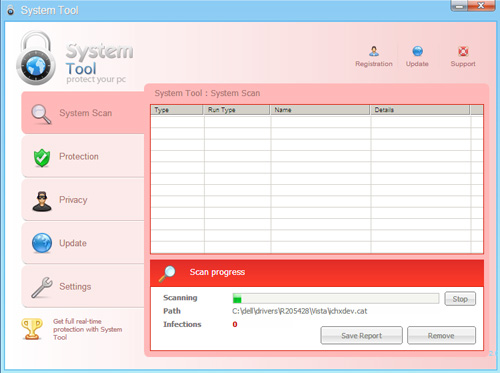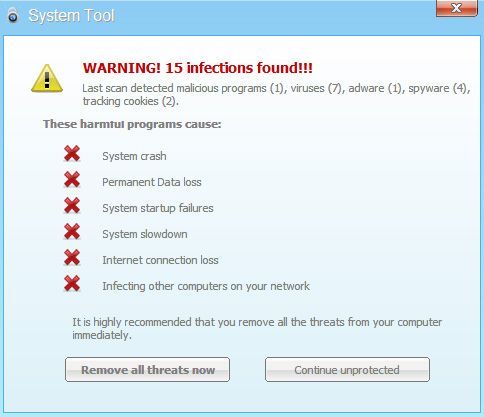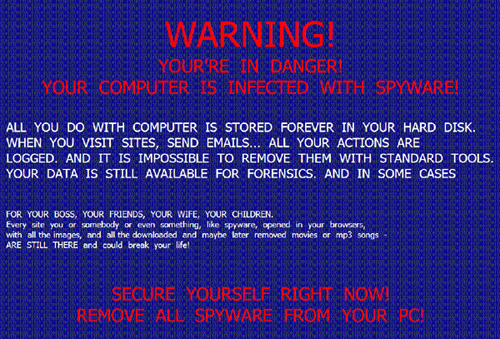TROJ_FAKEAV.FDHQ
Windows 2000, Windows XP, Windows Server 2003


Threat Type: Trojan
Destructiveness: No
Encrypted: No
In the wild: Yes
OVERVIEW
This Trojan may be dropped by other malware. It may be unknowingly downloaded by a user while visiting malicious websites. It may be manually installed by a user.
It deletes itself after execution.
It displays fake alerts.
TECHNICAL DETAILS
Arrival Details
This Trojan may be dropped by other malware.
It may be unknowingly downloaded by a user while visiting malicious websites.
It may be manually installed by a user.
Installation
This Trojan drops the following copies of itself into the affected system:
- %Application Data%\{random folder name}\{random file name}.exe
(Note: %Application Data% is the current user's Application Data folder, which is usually C:\Windows\Profiles\{user name}\Application Data on Windows 98 and ME, C:\WINNT\Profiles\{user name}\Application Data on Windows NT, and C:\Documents and Settings\{user name}\Local Settings\Application Data on Windows 2000, XP, and Server 2003.)
It drops the following non-malicious files:
- %Application Data%\{random folder name}\{random file name}
- %System Root%\fsqwr.bmp - fake blue screen image
(Note: %Application Data% is the current user's Application Data folder, which is usually C:\Windows\Profiles\{user name}\Application Data on Windows 98 and ME, C:\WINNT\Profiles\{user name}\Application Data on Windows NT, and C:\Documents and Settings\{user name}\Local Settings\Application Data on Windows 2000, XP, and Server 2003.. %System Root% is the root folder, which is usually C:\. It is also where the operating system is located.)
It adds the following mutexes to ensure that only one of its copies runs at any one time:
- Don't stop me! I give work and money for you!
Autostart Technique
This Trojan adds the following registry entries to enable its automatic execution at every system startup:
HKEY_CURRENT_USER\Software\Microsoft\
Windows\CurrentVersion\RunOnce
{random file name} = "%Application Data%\{random folder name}\{random file name}.exe"
Other System Modifications
This Trojan sets the system's desktop wallpaper to the following image:
Other Details
This Trojan deletes itself after execution.
Rogue Antivirus Routine
This Trojan displays fake alerts.
NOTES:
This Trojan poses as a legitimate antivirus called System Tool. It uses a convincing graphical user interface and warning messages to indicate that the system is infected.




- http://{BLOCKED}.{BLOCKED}.216.82/buy.php?affid={id}
- http://{BLOCKED}.{BLOCKED}.209.245/buy.php?affid={id}
SOLUTION
Step 1
For Windows XP and Windows Server 2003 users, before doing any scans, please make sure you disable System Restore to allow full scanning of your computer.
Step 2
Restart in Safe Mode
Step 3
Search and delete these files
%Application Data%\{random1}\{random1}
%Application Data%\{random1}\{random1}.exe
Step 4
Delete this registry value
Important: Editing the Windows Registry incorrectly can lead to irreversible system malfunction. Please do this step only if you know how or you can ask assistance from your system administrator. Else, check this Microsoft article first before modifying your computer's registry.
- In HKEY_CURRENT_USER\Software\Microsoft\Windows\CurrentVersion\RunOnce
- {random1} = %Application Data%\{random1}\{random1}.exe
- {random1} = %Application Data%\{random1}\{random1}.exe
Step 5
Restart in normal mode and scan your computer with your Trend Micro product for files detected as TROJ_FAKEAV.FDHQ. If the detected files have already been cleaned, deleted, or quarantined by your Trend Micro product, no further step is required. You may opt to simply delete the quarantined files. Please check this Knowledge Base page for more information.
Step 6
Scan your computer with your Trend Micro product to delete files detected as TROJ_FAKEAV.FDHQ. If the detected files have already been cleaned, deleted, or quarantined by your Trend Micro product, no further step is required. You may opt to simply delete the quarantined files. Please check this Knowledge Base page for more information.
Did this description help? Tell us how we did.


